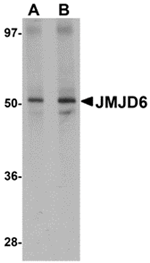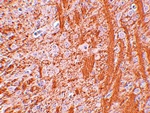The jumonji domain-containing protein (JMJD) family is defined by the presence of the JmjC domain that is observed in several diverse species. JMJD6 was initially identified as a membrane protein that participates in phagocytosis but recent studies have shown that it has other functions when it is expressed in the cytosol and nucleus. JMJD6 is thought to play important roles in regulation of development and differentiation as knockdown experiments in mice resulted in neonatal lethality with severe defects in the morphology of numerous organs. JMJD6 also can catalyze the lysyl-hydroxylation of U2AF65, a protein involved with RNA splicing, suggesting that some of the functions attributed to JMJD6 may be due to its regulatory activity of RNA splicing.


